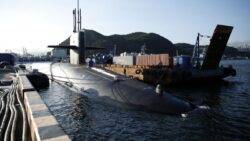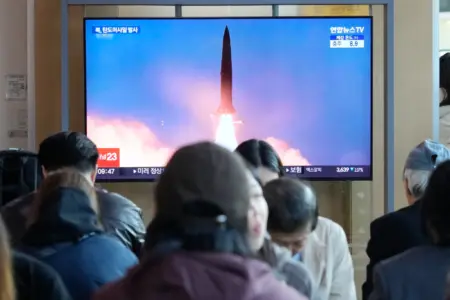Periodic visits by US nuclear ballistic missile-capable submarines to South Korea were one of several agreements reached by President Joe Biden and South Korean President Yoon Suk Yeol in April in response to North Korea’s expanding nuclear threat.
South Korea’s President Yoon Suk Yeol boarded an American nuclear-capable submarine in the southern port city of Busan on Wednesday. It was the first time in more than four decades that a United States’ submarine of this type has docked in the country.
And the president’s visit to it was intended to send a strong message to North Korea.
“South Korea and the US will show overwhelming response to North Korea’s heightened nuclear threats through Nuclear Consultative Group and by regularly deploying strategic assets such as SSBNs (ballistic missile submarines),” Yoon said.
Periodic visits by US nuclear ballistic missile-capable submarines to South Korea were one of several agreements reached by President Joe Biden and South Korean President Yoon Suk Yeol in April in response to North Korea’s expanding nuclear threat.
They also agreed to further expand combined military exercises, strengthen joint planning for nuclear contingencies and establish a bilateral Nuclear Consultative Group, which held its inaugural meeting in Seoul on Tuesday.
The steps were meant to ease South Korean concerns about North Korea’s growing nuclear weapons arsenal and suppress voices within the South calling for the country to pursue its own nuclear weapons program.
Pyongyang fired two short-range ballistic missiles into the sea as the vessel docked, in what appeared to be a statement of defiance.
China meanwhile says it’s concerned about the escalation of regional tensions that it says undermines the de-nuclearisation of the Korean peninsula.
US Forces Korea said in a statement that the Kentucky’s arrival in Busan reflects the United States’ “ironclad” commitment to “extended deterrence,” referring to an assurance to defend its ally with its full military capabilities, including nuclear ones.
The Ohio-class submarine can be equipped with about 20 Trident II ballistic missiles with a range of 12,000 kilometres, according to South Korea’s military.
“From this submarine, the US can launch attacks (on North Korea) from anywhere in the world,” said Moon Keun-sik, a submarine expert who teaches at Kyonggi University in South Korea. “But there will likely be backlashes from North Korea and China because it’s like the world’s most covert and threatening nuclear weapons forces being deployed on their doorsteps.”
While some South Korean conservatives have expressed disappointment that the Biden-Yoon meeting in April came short of agreeing to station US nuclear weapons or strategic assets in the South, placing nuclear weapons offshore and on submarines is “actually a stronger deterrent in many ways,” said Duyeon Kim, a senior analyst at Washington’s Center for a New American Security.
“Deterrence is strengthened when the location of American strategic assets is unknown to the adversary as long as the adversary knows that these weapons exist,” said Kim.
Still, Seoul and Washington will need to find the “sweet spot” when it comes to the visibility of America’s extended deterrent.
“Too much visibility of strategic assets could actually undermine the deterrent effect while too little could raise questions in Seoul about commitment,” Kim said.





